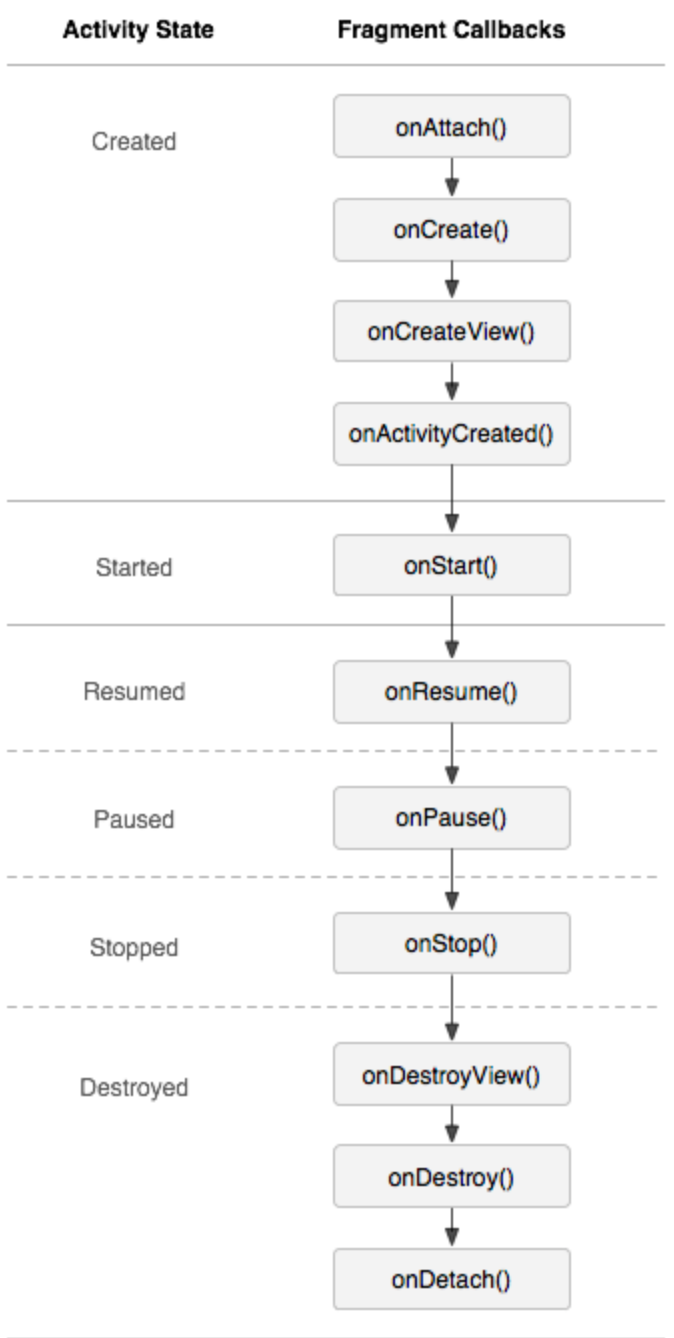前言
在Android3.0的时候被引入,它的出现主要是给大屏幕设备提供更加灵活的UI支持。通过对Activity布局进行分片,更加方便的对每块进行独立控制。这些片段可以被不同的activity复用。
Fragment生命周期
Fragment必须是依存与Activity而存在的,因此Activity的生命周期会直接影响到Fragment的生命周期。官网这张图很好的说明了两者生命周期的关系:
可以看到Fragment比Activity多了几个额外的生命周期回调方法:
1.onAttach(Activity):
当Fragment与Activity发生关联时调用。
2.onCreateView(LayoutInflater, ViewGroup,Bundle)
创建该Fragment的视图
3.onActivityCreated(Bundle)
当Activity的onCreate方法返回时调用
4.onDestoryView()
与onCreateView相对应,当该Fragment的视图被移除时调用
5.onDestory
销毁fragment时回调
6.onDetach()
与onAttach相对应,当Fragment与Activity关联被取消时调用
tips:除了onCreateView,其他的所有方法如果你重写了,必须调用父类对于该方法的实现.
Activity如何向Fragment传值?
(1)在Fragment 的getInstance()方法中setArguments()设置参数
public static Fragment getInstance(String message){
Bundle bundle = new Bundle();
bundle.putString("msg",message);
MainFragment fragment=new MainFragment();
fragment.setArguments(bundle);
return fragment;
}(2)在MainFragment中通过getArguments()方法获取传值
public void getData() {
Bundle bundle=getArguments();
if(bundle!=null){
String msg=bundle.getString("msg");
Log.e("从activity中获取值为:",msg);
}
}Fragment如何向Activity传值
一般来说有两种方案,第一种是通过接口回调的方式,另外一种是通过广播的形式,下面对这两种方式做介绍:
1.接口回调方式
在fragment类中定义一个接口并在Activity中实现它。Fragment在onAttach(Activity activity)回调函数中获取接口的具体实现的对象。进而fragment就可以调用接口中的方法实现与Activity的通信。
public interface callBack{
void showMsg(String message);
}
private callBack mCallBack;
@Override
public void onAttach(Activity activity) {
super.onAttach(activity);
try {
if(activity!=null){
mCallBack=(MainActivity)activity;
}
} catch (ClassCastException e) {
throw new ClassCastException(
" activity must implement callBack");
}
}
public void onClick(View view) {
mCallBack.showMsg("回调activity中的方法");
}
});
在Activity中需要实现callBack接口
@Override
public void showMsg(String message) {
if(!TextUtils.isEmpty(message)){
Log.e("得到Fragment的传值为:",message);
}
}2.广播的方式
在Activity中注册广播接收器,在Fragment中发送广播,进而实现Fragment向activity传值.
private BroadcastReceiver mBroadcastReceiver = new BroadcastReceiver() {
@Override
public void onReceive(Context context, Intent intent) {
String action = intent.getAction();
if (action.equals(ACTION_NAME)) {
String msg = intent.getStringExtra("msg");
Toast.makeText(MainActivity.this, msg, Toast.LENGTH_SHORT).show();
}
}
};
public void registerBoradcastReceiver() {
IntentFilter myIntentFilter = new IntentFilter();
myIntentFilter.addAction(ACTION_NAME);
registerReceiver(mBroadcastReceiver, myIntentFilter);
}
@Override
protected void onDestroy() {
super.onDestroy();
unregisterReceiver(mBroadcastReceiver);
}
实际开发中推荐使用接口回传的方式,不建议使用广播的方式。
根据广播的注册方式可以分为两种:
第一种是常驻的注册方式,即,当程序关闭后,若有消息传来,一样会自动进行响应。
第二种不是常驻的注册方式,及会随着Activity的生命周期的变化而变化。上面使用的就是这种方式























 1188
1188

 被折叠的 条评论
为什么被折叠?
被折叠的 条评论
为什么被折叠?








